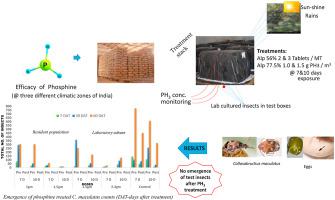当前位置:
X-MOL 学术
›
Crop Prot.
›
论文详情
Our official English website, www.x-mol.net, welcomes your feedback! (Note: you will need to create a separate account there.)
Locational dynamics of concentration and efficacy of phosphine against pulse beetle, Callosobruchus maculatus (Fab)
Crop Protection ( IF 2.8 ) Pub Date : 2020-11-01 , DOI: 10.1016/j.cropro.2020.105475 Sumitra Arora , C. Srivastava
Crop Protection ( IF 2.8 ) Pub Date : 2020-11-01 , DOI: 10.1016/j.cropro.2020.105475 Sumitra Arora , C. Srivastava

|
Abstract Phosphine is considered as an effective substitute to methyl bromide (MB), an ozone depleting fumigant which was phased out honouring ‘Montreal Protocol’. Limited field studies are available on phosphine toxicity against storage insects of pulses under different climatic conditions in India. In the present study phosphine efficacy was investigated against laboratory cultured and field populations of Callosobruchus maculatus by organising field fumigation trials of 5 MT pulse stacks, each in triplicate, under varied climatic conditions. The trials were conducted at three locations, Jaipur for Cicer arietinum (chickpea), Cuttack for Vigna radiata (green gram) and Mumbai for Lathyrus aphaca (yellow pea) using conventional 56% Aluminium phosphide (AlP) tablets (2 tab/MT and 3 tab/MT) application; and gas derived from on-site phosphine generator with 77.5% granular (1.0 g and 1.5 g phosphine/m3) formulations for two exposure periods (7 and 10-days) for each dosage including untreated control. Phosphine gas concentration was monitored daily until the exposure periods using gas monitoring equipment. No emergence of adults was observed until 60 days after treatment indicating 100% insect mortality of both populations (laboratory and field) for both exposure periods using all dosages. The minimum effective phosphine gas concentration for controlling C. maculatus was observed as 300-500 ppm for 7-days exposure using 1.5 g phosphine/m3 depending on climatic conditions. A significant variation was observed in gas concentration monitored during fumigation of pulses at different locations. Average concentration-time (Ct) product for green gram was higher than that of chickpea and yellowpea. The loss of gas concentration was found to be significantly low in yellowpea treated with phosphine at moderately hot and humid climate.
中文翻译:

磷化氢对脉冲甲虫 Callosobruchus maculatus (Fab) 的浓度和功效的位置动态
摘要 膦被认为是甲基溴 (MB) 的有效替代品,甲基溴是一种消耗臭氧层的熏蒸剂,根据《蒙特利尔议定书》已被淘汰。印度不同气候条件下磷化氢对豆类贮藏昆虫的毒性的实地研究有限。在本研究中,通过组织 5 MT 脉冲堆的现场熏蒸试验,在不同的气候条件下,每个重复三次,研究了磷化氢对实验室培养和野外种群的 Callosobruchus maculatus 的功效。试验在三个地点进行,使用传统的 56% 磷化铝 (AlP) 片剂(2 片/吨和 3标签/MT)应用程序;和来自现场磷化氢发生器的气体,具有 77.5% 的颗粒(1.0 克和 1.5 克磷化氢/立方米)配方,每个剂量的两个暴露期(7 天和 10 天),包括未处理的对照。使用气体监测设备每天监测磷化氢气体浓度直至暴露期。直到处理后 60 天才观察到成虫出现,表明在使用所有剂量的两个暴露期,两个种群(实验室和田间)的昆虫死亡率均为 100%。根据气候条件,使用 1.5 g 膦/m3 暴露 7 天,观察到控制 C. maculatus 的最低有效磷化氢气体浓度为 300-500 ppm。在不同位置熏蒸脉冲期间监测到的气体浓度存在显着变化。绿豆的平均浓度-时间 (Ct) 乘积高于鹰嘴豆和黄豆。在适度炎热和潮湿的气候下,用磷化氢处理的黄豌豆中的气体浓度损失显着降低。
更新日期:2020-11-01
中文翻译:

磷化氢对脉冲甲虫 Callosobruchus maculatus (Fab) 的浓度和功效的位置动态
摘要 膦被认为是甲基溴 (MB) 的有效替代品,甲基溴是一种消耗臭氧层的熏蒸剂,根据《蒙特利尔议定书》已被淘汰。印度不同气候条件下磷化氢对豆类贮藏昆虫的毒性的实地研究有限。在本研究中,通过组织 5 MT 脉冲堆的现场熏蒸试验,在不同的气候条件下,每个重复三次,研究了磷化氢对实验室培养和野外种群的 Callosobruchus maculatus 的功效。试验在三个地点进行,使用传统的 56% 磷化铝 (AlP) 片剂(2 片/吨和 3标签/MT)应用程序;和来自现场磷化氢发生器的气体,具有 77.5% 的颗粒(1.0 克和 1.5 克磷化氢/立方米)配方,每个剂量的两个暴露期(7 天和 10 天),包括未处理的对照。使用气体监测设备每天监测磷化氢气体浓度直至暴露期。直到处理后 60 天才观察到成虫出现,表明在使用所有剂量的两个暴露期,两个种群(实验室和田间)的昆虫死亡率均为 100%。根据气候条件,使用 1.5 g 膦/m3 暴露 7 天,观察到控制 C. maculatus 的最低有效磷化氢气体浓度为 300-500 ppm。在不同位置熏蒸脉冲期间监测到的气体浓度存在显着变化。绿豆的平均浓度-时间 (Ct) 乘积高于鹰嘴豆和黄豆。在适度炎热和潮湿的气候下,用磷化氢处理的黄豌豆中的气体浓度损失显着降低。



























 京公网安备 11010802027423号
京公网安备 11010802027423号